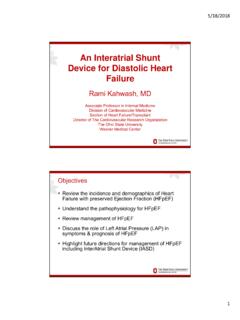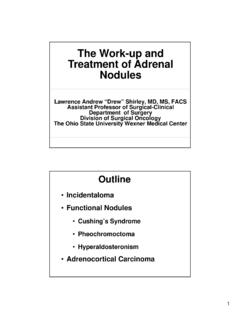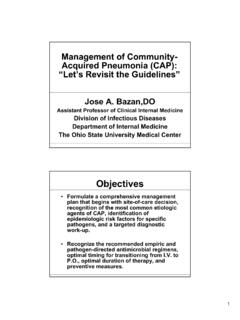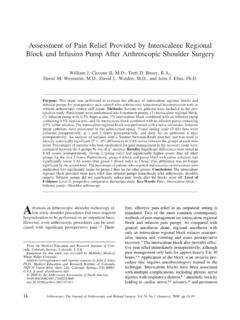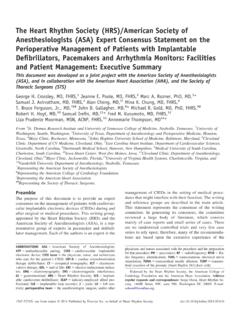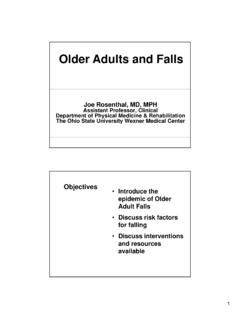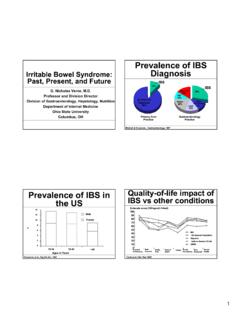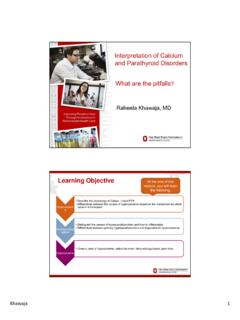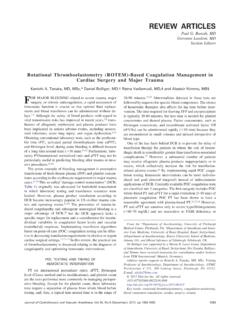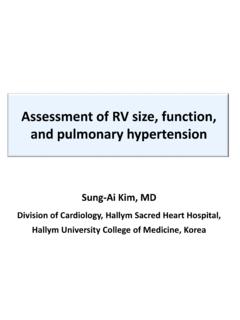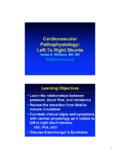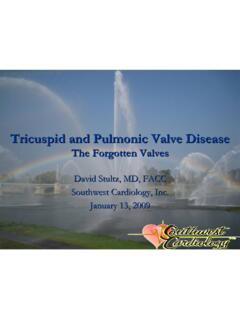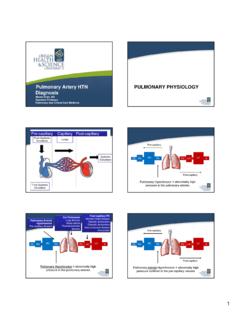Transcription of Pulmonary Arterial Hypertension Final - Handout.ppt
1 1 Pulmonary Arterial Hypertension : Pulmonary Arterial Hypertension : Diagnosis of Treatment Diagnosis of Treatment Pulmonary Arterial Hypertension : Pulmonary Arterial Hypertension : Diagnosis of Treatment Diagnosis of Treatment Namita Sood, MD, FCCPD irector, Pulmonary Hypertension ProgramAssociate Professor - ClinicalDepartment of Internal MedicineThe Ohio State University Wexner Medical CenterPAHPAH Classification Diagnosis Current treatmentPulmonary CirculationPulmonary Circulation Originates from the RV Low Pressure, low resistance circuit Thin-walled vessels High compliance Receives entire CO from RV Accommodates wide range of CO without increase in PVRP ulmonary circulationPulmonary circulation2 Pulmonary HypertensionPulmonary Hypertension Mean PAP > 25 mmHg Not just one disease, but a large fj,ggroup of diverse diseasesClassificationClassification1.
2 Pulmonary Arterial Hypertension (PAH) 1. Pulmonary Arterial Hypertension (PAH) Idiopathic (IPAH) Heritable BMPR2 ALKI Endoglin (with or without HHT) Unknown and Toxinsg Associated with (APAH): Collagen vascular disease HIV Portal Hypertension Congenital Heart Disease Schistosomiasis 1 1 Pulmonary veno-occlusive disease (PVOD)/ Pulmonary capillary hemangiomatosis (PCH) 1 2 Persistent Pulmonary Hypertension of the newbornClassificationClassification2. Pulmonary Hypertension with left heart Left Ventricular Systolic Left Ventricular Diastolic Valvular Disease2,4 Congenital /Aquired Left Heart inflow tract obstruction and congenital cardiomyopathiesobstruction and congenital cardiomyopathies3. Pulmonary Hypertension associated with lung diseases and/or Chronic obstructive Pulmonary Interstitial lung Sleep-disordered Alveolar hypoventilation Chronic exposure to high Developmental abnormalitiesClassificationClassificatio n4.
3 Pulmonary Hypertension due to chronic thromboembolic3 ClassificationClassification 5. Pulmonary Hypertension with unclear multifactorial mechanism Hematologic disorders, myeloproliferative disorders, splenectomy Sarcoidosis, histiocytosis X, lymphangioleiomyomatosislymphangioleiomy omatosis Metabolic disorders, glycogen storage disease, Gaucher disease,thyroid Compression of Pulmonary vessels tumor obstruction, fibrosing mediastinitis, Chronic renal failure Pulmonary Arterial HypertensionPulmonary Arterial Hypertensionmean Pulmonary artery pressure > 25 mm Hg Pulmonary artery wedge pressure <15 Incidence of PAHI ncidence of PAH 187 patients followed over 7 years Mean age at diagnosis: 36 years Almost 2:1 female-to-male ratio 647 patients in 1 yr Prevalence increasing: 15 cases per million IPAH = per million Mean delay between enrollment andratio Incidence: ~2 cases per 100,000 Mean survival yrs Mean duration of symptoms before diagnosis:2 yearsenrollment and diagnosis: 6 86 monthsA Disease of Decline and Deterioration: IPAH Survival if UntreatedA Disease of Decline and Deterioration: IPAH Survival if Untreated6080100e survivingNIH registrySitbon historical controlACCP estimate Poor prognosis in an era lacking therapyAdapted from: Sitbon O et al.
4 J Am Coll ;40:780-788;D Alonzo GE. Ann Intern ;115:343-349; and McLaughlin VV et al. Chest. 2004;126 of follow-upPercentage Therapeutic options and research efforts now offer more hope4 REVEAL: Observed 1-year Survival From Time of Enrollment According to Predicted Risk StrataREVEAL: Observed 1-year Survival From Time of Enrollment According to Predicted Risk StrataSurvival (%)6010080 Risk strataLowAverageModerately highBenza RL et al. Circulation. 2010;122 from enrollment0400369122581114710 HighVery highNo. at risk:LowAverageMod. highHighVery high 1374665280295102136865927729310013646572 7429196135965326928489135664826427781135 2647263270741351640260263721346628259255 6913416252552476113366182542415913116042 4923855130460224423352130359624322549 PAH Registries: Functional Class at Diagnosis Indicates Delayed DiagnosisPAH Registries: Functional Class at Diagnosis Indicates Delayed Diagnosis% Patients NYHA Functional Class III-IV at Diagnosist 1008060 Frost AE.
5 CHEST 2008. October 25-30, 2008, Philadelphia, PA. Session (N=2967)REVEAL-TR(N=2364)REVEAL-NIH(N=10 09)PHC(N=578)NIH(N=187)French(N=674)6040 200 Common Initial Symptoms Common Initial Symptoms (N=187)(N=187)Patients (%) Patients (%) Dyspnea60 Fatigue19Is There a Reason to Suspect PAH?Is There a Reason to Suspect PAH?Clinical PresentationFatigue19 Syncope or near syncope13 Chest pain7 Palpitations5 Leg edema3 McGoon M et al for the American College of Chest Physicians. ;126 S et al. Ann Intern ;107 ExamPhysical ExamPresence of PHPresence of PH Loud P2 Loud P2 RV liftRV liftPresence of RV FailurePresence of RV Failure JVD with V waveJVD with V wave RV S3RV S3 Systolic murmur (TR)Systolic murmur (TR) Diastolic murmur (PR)Diastolic murmur (PR) RV S4RV S4 HepatomegalyHepatomegaly EdemaEdema AscitesAscites5 Chest XChest X--RayRayProminent ProximalPulmonary ArteriesChest XChest X--RayRayPeripheral Hypovascularity(Pruning)Chest XChest X--RayRayRV Enlargement into Retrosternal Clear SpaceECGIs There a Reason to Suspect PAH?
6 Is There a Reason to Suspect PAH?RVHRADRVHRV StrainRAEMcGoon M et al for the American College of Chest Physicians. ;126 EvaluationDiagnostic Evaluation Pulmonary function tests Mild restrictive defects Decreased DLCOAt i lBl d Arterial Blood gas Hypoxemia Increased A-a gradientChest XChest X--RayRayPeripheral Hypovascularity(Pruning)Prominent ProximalPulmonary ArteriesRV Enlargement into Retrosternal Clear SpaceCardiovascular EvaluationCardiovascular EvaluationChamber size LV and RV systolic functionLV diastolic functionValvular functionTRBubble studyCardiovascular EvaluationCardiovascular m/sec = 70 mmHg+ RA Pressure = PA 80 mmHg7 Diagnostic ApproachDiagnostic ApproachPFTsSleepstudyVentilation-RVE, RAE, RVSPLeft heart diseaseVHDCHDE mphysemaILDT horacic abnlSleepdisorderExamCXRECGE chocardiogramVentilation-perfusion scan,Contrast CT,AngiographyAutoantibodytestsHIV testLFTs and clinicalevidence of cirrhosisand portal htnChronicthrombo-embolismSclerodermaSLE RAV asculitisHIVP ortopulmonaryhypertension Functional test BNP RH cath Vasodilator testMcLaughlin VV, McGoon Michael D.
7 Circulation. 2006;114 testingExercise testing Six minute walk Cardiopulmonary exercise test Assessment of functional status Response to therapy Response to therapyFunctional AssessmentFunctional AssessmentClass IClass INo limitation of physical activity. No limitation of physical activity. Ordinary physical activity does not cause undue Ordinary physical activity does not cause undue dyspneadyspnea or or fatigue, chest pain or near , chest pain or near IIClass IISlight limitation of physical activity. Slight limitation of physical activity. Ordinary physical activity causes undue Ordinary physical activity causes undue dyspneadyspnea or fatigue, or fatigue, chest pain or near pain or near IIIC lass IIIM arked limitation of physical limitation of physical than ordinary physical activity causes undue Less than ordinary physical activity causes undue dyspneadyspnea or or fatigue, chest pain or near , chest pain or near IVClass IVInability to perform any physical activity without symptoms.
8 Inability to perform any physical activity without symptoms. Signs of right heart failure. Signs of right heart failure. DyspneaDyspnea and/or fatigue may be present at rest, and and/or fatigue may be present at rest, and discomfort is increased by any physical is increased by any physical S ed. Executive summary of the World Congress on PPH 1998. * New York Heart Health Org. modificationNYHA Staging / Survival in PPHNYHA Staging / Survival in PPHNYHA IIINYHA IVStage0 10203040506070 NYHA IISM onths8 Right Heart CatheterizationRight Heart Catheterization Invasive measurement of : Right atrial Pressure Right ventricular Pressures PA Pressure Pulmonary capillary wedge pressurepressure Mixed venous oxygen saturation Cardiac output Vasodilator challenge Image from EchocardiogramPFT sVQ Scan Chronic PEHistoryExamCXRECGTEEE xercise EchoPulmonary AngiographyChest CT AngiogramCoagulopathy ProfileABG s Index of Suspicion of PH RVE, RAE, RVSP, RV Function Left Heart Disease VHD, CHD Ventilatory Function Gas ExchangePivotal TestsContingent TestsContribute to Assessment of.
9 Gnostic AlgorithmPolysomnography Sleep DisorderFunctional Test(6 MWT, CPET)Overnight OximetryHIVANALFT sRH CathVasodilator TestExercise RH CathVolume LoadingOther CTD Serologies HIV Infection Scleroderma, SLE, RA Portopulmonary Htn Establish Baseline Prognosis Confirmation of PH Hemodynamic Profile Vasodilator ResponseLeft Heart CathMcLaughlin VV et Am Coll ;53 DiagRISK FACTORS ANDASSOCIATED CONDITIONS Collagen vascular disease Congenital heart disease Portal Hypertension HIV infection Drugs and toxins PregnancyVASCULAR INJURYE ndothelial Dysfunction Nitric oxide synthase Prostacyclin production Thromboxane production Endothelin 1 productionVascular Smooth Muscle DysfunctionImpaired voltage-gated potassium channel ( )DISEASE PROGRESSIONLoss of response to short-acting vasodilator trialSUSCEPTIBILITY Abnormal BMPR2gene Other genetic factors123 Mechanisms of Disease PathologyMechanisms of Disease PathologyGaine S.
10 ;284 DISEASEIRREVERSIBLE DISEASEPre-symptomatic/ CompensatedSymptomatic/ DecompensatingDeclining/ DecompensatedProgression of PAH Progression of PAH TimePAPPVRCOS ymptom ThresholdRight Heart Dysfunction9 TreatmentTreatmentGeneral measures Supplemental oxygen Diuretics Diuretics Digoxin AnticoagulationAnticoagulationAnticoagul ationRationale: Fresh intrapulmonary clots High risk for thromboembolic event Improved survival Treatment Warfarin- goal INR Inotropic effect: variable Used in varying number of patients in major center trials of PAHRich S et al. ;114:787 792. Short-term administration associated with an increase in cardiac output and reduced circulating catecholamines No long-term data available DiureticsDiuretics Majority of patients require them Variable response Follow renal and electrolyte tparameters Individual patient assessment10 OxygenOxygen Hypoxemia is detrimental: results in vaso-constriction Altitude and sleep may result in hypoxemiayp In congenital heart disease, probably no benefitOther Management IssuesOther Management Issues Encourage exercise and activity within the limits of disease and ability to maintain O2levels Immunizations ContraceptionCalcium Channel BlockersCalcium Channel BlockersRationale: Rich et al NEJM 1992.
